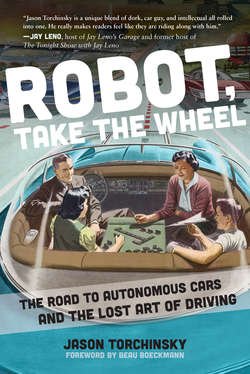Читать книгу Robot, Take the Wheel - Jason Torchinsky - Страница 11
На сайте Литреса книга снята с продажи.
How Did We Get Here?
ОглавлениеThe goal of a hell of a lot of human inventions is to get out of having to do work. To anyone who has spent any time around humans, this should come as no surprise at all. Work sucks. If I were smart enough to make a machine or program an algorithm to write this book, I would have, no question. The problem is everything I tried just produced long strings of profanity with the occasional phrase “robot cars” stuck in there, and my editors didn’t go for it. So here we are.
This mentality is also what led to the development of automobiles. We very quickly realized that walking on our own and hauling our own stuff is awful, just awful, so we forced animals to do it for us, and that worked for centuries, until we just couldn’t take staring at a horse or donkey anus from the seat of a wagon anymore, and so the concept of the automobile was born.
I mean, sure, we had to wait until we had a viable power source in the form of, initially, steam power, which was also crucial in finding ways to keep from having to do work. The development of the automobile in general is fascinating, and I originally wanted to write that book but autonomous cars are on everyone’s mind right now; I’ll get to that history another time.
For the moment, let’s just accept that self-propulsion was developed and applied to vehicles, and let’s talk about the logical development beyond self-propelled vehicles: self-guided vehicles. The idea of a vehicle that is capable of not just propelling itself, but actually going where you tell it to go, with no further attention or interaction needed, has been around a lot longer than most people would imagine. Some of this may come from a subtle, unspoken desire to replicate animal power; as I said earlier, animal-powered human transportation was at least semiautonomous, and animals on their own are fully autonomous, though you could argue that if you dangle some bacon in front of a dog you have effectively taken control over that autonomy.
There are several levels of autonomy going on here: at the most basic level, any self-propelled vehicle is capable of some kind of autonomous travel, even if that just means going forward until it hits something, runs out of fuel, or, for all you flat-earthers reading this, plummets over the side of the Frisbee-shaped planet that you, somehow, believe in.
One step ahead would be to be able to drive according to some set of preprogrammed instructions, sort of like that old ’80s toy, the Big Trak. Vehicles of this nature can “play back” a set of instructions: move ahead five units, turn left, pause, that sort of thing. This sort of semiautonomy isn’t really autonomy at all, and does not require a machine to have any ability to sense its environment and react accordingly.
Beyond that would be semiautonomous vehicles that rely on sensing very specific external objects, markings, or forces. Think of a car designed to follow a magnetic strip inset into a road, or a robot that uses an optical sensor to follow a line on the ground. These are doing some sensing of their environment, but the environment itself must be tailored to a very specific set of conditions that the machine has been designed to react to.
Then we get to more advanced environmental sensing and reaction; at this level, some degree of computation—first analog, then later digital—is required. Early aircraft autopilot systems used compasses, gyroscopes (a device that uses spinning discs to maintain a reference direction), airspeed indicators, and other equipment to get a sense of where they were going and how fast. While early systems weren’t exactly computers, they were sort of like analog almost-computers, reacting to input to determine the environment and act accordingly.
These systems could keep a course, but not actively avoid obstacles; to accomplish this, real machine “vision” had to be developed—and that’s a colossal undertaking, the development of which is never-ending—and forms the basis for how modern autonomous vehicle technology works. Modern systems are capable of identifying objects and making best guesses about the nature of the object, and from there extrapolating how it may behave. For instance, something identified as a tree is obviously far more likely to photosynthesize and remain stationary than something that’s been determined to be a human on a bicycle, which is far more likely to move, possibly erratically, and then corner you at a party and not shut up about how much better his life is ever since he started riding that damn bike.
There are, of course, important milestones at all these major stages of development, and unless you can fling this book across the room in time, I’m going to share a lot of these with you right now. In chronological order. So get ready.
The beginning of self-driving vehicle design goes back much further than I think most people would expect; in fact, it goes back further than the automobile itself.
Even if we take 1672 as a starting point for the automobile, when Ferdinand Verbiest made a small (think around two feet long), steam-powered vehicle to amuse the Kangxi Emperor of China, the first self-propelled machine with some crude semblance of autonomy was even earlier. And not just a little earlier; we’re talking two centuries earlier.
